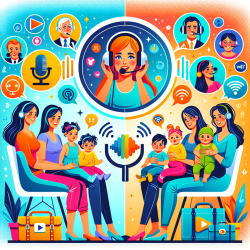Telepractice has emerged as a promising service delivery model for increasing access to speech-language pathology services, particularly for English learners (ELs) from Spanish-speaking households. A recent study titled The Social Validity of Telepractice among Spanish-Speaking Caregivers of English Learners: An Examination of Moderators sheds light on the perceptions and potential of telepractice among this demographic. This blog will explore the key findings and implications of this research to help practitioners improve their skills and encourage further research.
Key Findings
The study surveyed 79 Spanish-speaking caregivers of English learners to evaluate their interest in telepractice as a service delivery model. The key findings are as follows:
- Approximately 46% of the caregivers expressed interest in telepractice for their children.
- Caregivers with children diagnosed with a speech or language disorder were more likely to be interested in telepractice.
- Interest in telepractice was higher among caregivers who wanted Spanish language support for their children.
- Limited familiarity with telepractice was a significant barrier, with only 3.8% of participants having prior knowledge of it.
Implications for Practitioners
For speech-language pathologists (SLPs) and other service providers, these findings offer valuable insights into how telepractice can be better implemented and accepted among Spanish-speaking families. Here are some actionable steps:
- Educate Caregivers: Given the low familiarity with telepractice, it is crucial to provide comprehensive information to caregivers. This can include brochures, informational sessions, and Q&A forums to dispel myths and explain the benefits of telepractice.
- Highlight Spanish Language Support: Emphasize the availability of Spanish or bilingual services through telepractice, as this was a significant factor in caregiver interest.
- Address Technological Concerns: Many caregivers believed telepractice required owning a personal computer. Clarify that telepractice can be conducted through various devices, including tablets and smartphones, and provide information on low-cost technology options.
- Leverage Diagnosed Needs: Caregivers of children with diagnosed speech or language disorders showed higher interest in telepractice. Use this as a focal point to advocate for telepractice as a viable option for addressing these needs.
Encouraging Further Research
The study highlights the need for more research on telepractice, particularly among diverse linguistic populations. Future studies could explore:
- Long-term outcomes of telepractice compared to in-person services.
- Effectiveness of telepractice in various sociocultural contexts.
- Strategies for improving caregiver engagement and satisfaction with telepractice.
By continuing to investigate and address these areas, we can enhance the efficacy and acceptance of telepractice, ultimately leading to better outcomes for children.
To read the original research paper, please follow this link: The Social Validity of Telepractice among Spanish-Speaking Caregivers of English Learners: An Examination of Moderators.










